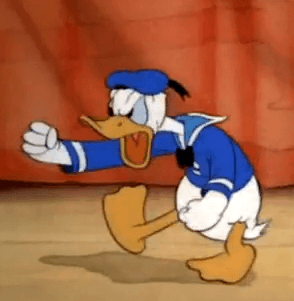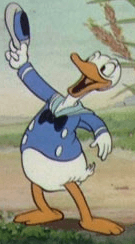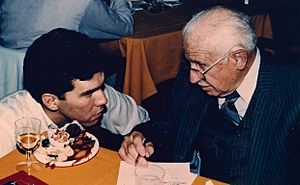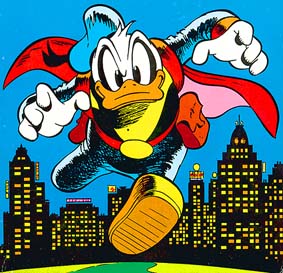Donald Duck facts for kids
Quick facts for kids Donald Duck |
|
|---|---|
| First appearance | The Wise Little Hen (1934) |
| Created by | Walt Disney |
| Voiced by | Clarence Nash (1934–1985) Tony Anselmo (1985–) |
| Developed by | Dick Lundy, Fred Spencer, Carl Barks, Jack Hannah |
| Information | |
| Full name | Donald Fauntleroy Duck |
| Nickname(s) | Don |
| Aliases | Frank Duck Fred Duck Avenger (USA) Superduck (UK) Italian: Paperinik Norwegian: Fantonald |
| Species | Pekin duck |
| Family | Duck family |
| Significant other(s) | Daisy Duck |
| Relatives | Scrooge McDuck (uncle) Ludwig Von Drake (granduncle) Huey, Dewey, and Louie (nephews) Clan McDuck (maternal relatives) |
Donald Duck is a cartoon character created by Walt Disney. He is a white duck with an orange bill and legs. He usually wears a sailor cap, a sailor shirt and a red bow tie. He first appeared on-screen in "The Little Red Hen" on 9 June 1934. Donald is Scrooge McDuck's nephew. His girlfriend is Daisy Duck. His nephews are Huey, Dewey and Louie. Donald appeared in animated shorts, comic books, and newspaper comic strips. Donald Duck appears frequently in "The Mickey Mouse Clubhouse".
Donald Duck has been voted as one of the most popular cartoon characters of all time. In addition to animation, Donald is well known worldwide for his appearances in comics.
Contents
Personality
The character of Donald Duck is portrayed as an impatient, immature, and arrogant duck with a pessimistic attitude and an insecure disposition. In addition, his two dominant personality traits are his fiery temper and his upbeat attitude to life. Many Donald shorts start with Donald in a happy mood, without a care in the world until something comes along and spoils his day. His rage is a great cause of suffering in his life. On multiple occasions, it has caused him to get in over his head and lose competitions. There are times when he fights to keep his temper in check, and he sometimes succeeds in doing so temporarily, but he always returns to his normal angry self in the end.
Donald's aggressive nature has its advantages, however. While at times it is a hindrance, and even a handicap, it has also helped him in times of need.
Donald is something of a prankster, and as a result, he can sometimes come across as a bit of a bully. However, with a few exceptions, there is seldom any harm in Donald's pranks. He almost never intends to hurt anyone, and when his pranks go too far, he is often apologetic.
Donald is also a bit of a poseur. He likes to brag, especially about how skilled he is at something. He does, in fact, have many skills—he is something of a Jack-of-all-trades. Amongst other things, he is a talented fisher, a competent hockey player, and a skilled pianist. However, his love of bragging often leads him to overestimate his abilities, so that when he sets out to make good on his boasts, he gets in over his head, usually to hilarious effect.
Another of his personality traits is perseverance. Even though he can at times be a slacker, and likes to say that his favorite place to be is in a hammock, once he has committed to accomplishing something he goes for it 100 percent, sometimes resorting to extreme measures to reach his goal.
Origin
Voice performer Clarence Nash auditioned for Walt Disney Studios when he learned that Disney was looking for people to create animal sounds for his cartoons. Disney was particularly impressed with Nash's duck imitation and chose him to voice the new character. Disney came up with Donald's iconic attributes including his short temper and his sailor suit (based on ducks and sailors both being associated with water). While Dick Huemer and Art Babbit were the first to animate Donald, Dick Lundy is credited for developing him as a character.
On April 29, 1934, five days before The Wise Little Hen's first theatrical release, bandleader Raymond Paige performed the score to the cartoon on his California Melodies program for the Los Angeles AM radio station KHJ. The main vocals were performed by a trio, the Three Rhythm Kings. Clarence Nash and Florence Gill performed the character voices for this radio treatment, with Nash performing both Donald Duck and Peter Pig, making it the first time the public heard Nash's duck voice.
An apocryphal alternative story for how Donald was created came about from a claim that Disney was watching an exhibition cricket match between Australia and the New York West Indians and Australia's star batsman Don Bradman was out for a duck. Disney allegedly used this as inspiration for the character. However, the veracity of this has been doubted by modern historians.
Animation
Early development
Donald Duck's first film appearance was in the 1934 cartoon The Wise Little Hen, which was part of the Silly Symphonies series of theatrical cartoon shorts. The film's given release date of June 9 is officially recognized by the Walt Disney Company as Donald's birthday, though historian J.B. Kaufman, consultant of The Walt Disney Family Museum, discovered in recent years that The Wise Little Hen was first shown on May 3, 1934, at the Carthay Circle Theater for a benefit program, while its official debut was on June 7 at the Radio City Music Hall. Donald's appearance in the cartoon, as created by animator Dick Lundy, is similar to his modern look – the feather and beak colors are the same, as are the blue sailor shirt and hat – but his features are more elongated, his body plumper, his feet smaller, and his sclerae white. Donald's personality is not developed either; in the short, he only fills the role of the unhelpful friend, along with acquaintance Peter Pig.
Burt Gillett brought Donald back in a 1934 Mickey Mouse cartoon, Orphans' Benefit. Donald is one of a number of characters who are giving performances in a benefit for Mickey's Orphans. Donald's act is to recite the poems Mary Had a Little Lamb and Little Boy Blue, but every time he tries, the mischievous orphans heckle him, leading the duck to fly into a squawking fit of anger. This explosive personality would remain with Donald for decades to come.
Donald continued to be a hit with audiences. The character began appearing regularly in most Mickey Mouse cartoons. Cartoons from this period, such as the cartoon The Band Concert (1935) – in which Donald repeatedly disrupts the Mickey Mouse Orchestra's rendition of The William Tell Overture by playing Turkey in the Straw – are regularly noted by critics as exemplary films and classics of animation. Animator Ben Sharpsteen also created the classic Mickey, Donald, and Goofy comedy in 1935, with the cartoon Mickey's Service Station.
In 1936, Donald was redesigned to be a bit fuller, rounder, and cuter, beginning with the cartoon Moving Day. He also began starring in solo cartoons, the first of which was Ben Sharpsteen's 1937 cartoon, Don Donald. This short also introduced a love interest of Donald's, Donna Duck, who evolved into Daisy Duck. Donald's nephews, Huey, Dewey and Louie, would make their first animated appearance a year later in the 1938 film, Donald's Nephews, directed by Jack King (they had been earlier introduced in the Donald Duck comic strip by Al Taliaferro, see below). By 1938, most polls showed that Donald was more popular than Mickey Mouse.
Wartime
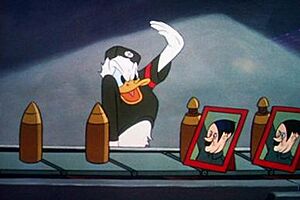
During World War II, Donald appeared in several animated propaganda films, including the 1943 Der Fuehrer's Face. In this cartoon, Donald plays a worker in an artillery factory in "Nutzi Land" (Nazi Germany). He struggles with long working hours, very small food rations, and having to salute every time he sees a picture of the Führer (Adolf Hitler). These pictures appear in many places, such as on the assembly line in which he is screwing in the detonators of various sizes of shells. In the end, he becomes little more than a small part in a faceless machine with no choice but to obey until he falls, suffering a nervous breakdown. Then Donald wakes up to find that his experience was, in fact, a dream. At the end of the short, Donald looks to the Statue of Liberty and the American flag with renewed appreciation. Der Fuehrer's Face won the 1942 Academy Award for Animated Short Film. Der Fuehrer's Face was also the first of two animated short films to be set during the War to win an Oscar, the other being Tom and Jerry's short film, The Yankee Doodle Mouse.
Other shorts from this period include a six film mini-series that follows Donald's life in the U.S. Army from his drafting to his experiences in basic training under Sergeant Pete to his first actual mission as a commando having to sabotage a Japanese air base. Titles in the series include:
- Donald Gets Drafted (May 1, 1942) (shown in his Selective Service Draft Card close-up, we learn Donald's full name: Donald Fauntleroy Duck)
- The Vanishing Private (September 25, 1942)
- Sky Trooper (November 8, 1942)
- Fall Out Fall In (April 23, 1943)
- The Old Army Game (November 5, 1943)
- Commando Duck (June 2, 1944)
Thanks in part to these films, Donald graced the nose artwork of virtually every type of World War II Allied combat aircraft, from the L-4 Grasshopper to the B-29 Superfortress.
Donald also appears as a mascot—such as in the United States Army Air Forces' 309th Fighter Squadron and the U.S. Coast Guard Auxiliary, which showed Donald as a fierce-looking pirate ready to defend the American coast from invaders. Donald also appeared as a mascot emblem for the 415th Fighter Squadron; 438th Fighter Squadron; 479th Bombardment Squadron; and 531st Bombardment Squadron. He also appeared as the mascot for the Fire Department at Marine Corps Air Station El Toro, as well as the Army Air Forces (now currently the United States Air Force) 319 Aircraft Maintenance Unit at Luke Air Force Base — where he is seen wearing an old-style pilot's uniform with a board with a nail in it in one hand, and a lightning bolt in the other hand. Donald's most famous appearance, however, was on the North American Aviation B-25B Mitchell medium bomber (S/N 40-2261) piloted by Lt. Ted W. Lawson of the 95th Bombardment Squadron, USAAF. The aircraft, named the "Ruptured Duck" and carrying a picture of Donald's face above a pair of crossed crutches, was one of sixteen B-25Bs which took off from the aircraft carrier USS Hornet to bomb Tokyo on April 18, 1942, during the Doolittle Raid. The mission was led by Lieutenant Colonel (later General) Jimmy Doolittle. Like most of the aircraft that participated in the mission, the Ruptured Duck was unable to reach its assigned landing field in China following the raid and ended up ditching off the coast near Shangchow, China. The Ruptured Duck's pilot survived, with the loss of a leg, and later wrote about the Doolittle Raid in the book, later to be the 1944 movie, Thirty Seconds Over Tokyo.
During World War II, Disney cartoons were not allowed to be imported into Occupied Europe owing to their propagandistic content. Since this lost Disney revenue, he decided to create a new audience for his films in South America. He decided to make a trip through various Latin American countries with his assistants, and use their experiences and impressions to create two feature-length animation films. The first was Saludos Amigos (1942), which consisted of four short segments, two of them with Donald Duck. In the first, he meets his parrot pal José Carioca. The second film was The Three Caballeros (1944), in which he meets his rooster friend Panchito.
Several decades after the war, because Donald was never officially separated from service in either his animated shorts or his comic strips, as part of Donald's 50th Birthday celebrations during the 25th Annual Torrance, California Armed Forces Day Parade, the U.S. Army retired Donald Duck from active duty as a "Buck Sergeant" (i.e. "Buck Sergeant Duck").
Post-war
Many of Donald's films made after the war recast the duck as the brunt of some other character's pestering. Donald is seen repeatedly attacked, harassed, and ridiculed by his nephews, by the chipmunks Chip 'n' Dale, or by other characters such as Humphrey the Bear, Spike the Bee, Bootle Beetle, the Aracuan Bird, Louie the Mountain Lion, or a colony of ants. In effect, much like Bugs Bunny cartoons from Warner Bros, the Disney artists had reversed the classic screwball scenario perfected by Walter Lantz and others in which the main character is the instigator of these harassing behaviors, rather than the butt of them.
The post-war Donald also starred in educational films, such as Donald in Mathmagic Land and How to Have an Accident at Work (both 1959), and made cameos in various Disney projects, such as The Reluctant Dragon (1941) and the Disneyland television show (1959). For this latter show, Donald's uncle Ludwig von Drake was created in 1961. Another uncle, Scrooge McDuck, made his first animated appearance on the program in 1967, after decades as a comics-only character.
In Who Framed Roger Rabbit (1988), Donald has a piano duel scene with his Warner Brothers counterpart Daffy Duck voiced by Mel Blanc. Donald has since appeared in several different television shows and (short) animated movies. He played roles in The Prince and the Pauper (1990) and made a cameo appearance in A Goofy Movie (1995).
Donald had a rather small part in the animated television series DuckTales. There, Donald joins the U.S. Navy and leaves his nephews Huey, Dewey, and Louie with their Uncle Scrooge, who then has to take care of them. Donald's role in the overall series was fairly limited, as he only ended up appearing in a handful of episodes when home on leave. Some of the stories in the series were loosely based on the comics by Carl Barks.
Donald made some cameo appearances in Bonkers, before getting his own television show Quack Pack. This series featured a modernized Duck family. Donald was no longer wearing his sailor suit and hat, but a Hawaiian shirt. Huey, Dewey, and Louie now are teenagers, with distinct clothing, voices, and personalities. Daisy Duck has lost her pink dress and bow and has a new haircut. No other family members, besides Ludwig von Drake, appear in Quack Pack, and all other Duckburg citizens are humans and not dogs.
He made a comeback as the star of the "Noah's Ark" segment of Fantasia 2000 (1999), as first mate to Noah. Donald musters the animals to the Ark and attempts to control them. He tragically believes that Daisy has been lost, while she believes the same of him, but they are reunited at the end. All this to Edward Elgar's Pomp and Circumstance Marches 1–4.
In an alternate opening for the Disney film Chicken Little (2005), Donald would have made a cameo appearance as "Ducky Lucky". This scene can be found on the Chicken Little DVD.
Donald also played an important role in Mickey Mouse Works and House of Mouse. In the latter show, he is the co-owner of Mickey's nightclub. He is part of the ensemble cast of characters in the TV show Mickey Mouse Clubhouse as well. He also appears in the new 3-minute Mickey Mouse TV shorts for Disney Channel.
Donald also appears in the DuckTales reboot, in which he is a main character as opposed to his minor role in the original cartoon. The series depicts him as having once been Scrooge's partner in adventure along with his sister Della. However, ten years prior to the series' beginning, Della went missing, leading to Donald and Scrooge going their separate ways and not speaking to each other throughout that time. In the present, Donald reluctantly brings Della's sons and his legal charges, the triplets, to Scrooge's mansion so he can babysit them while Donald attends a job interview, though he still has not forgiven Scrooge for their past history. Donald is temporarily hired by Scrooge's rival Flintheart Glomgold and ends up at the city of Atlantis, where Scrooge has also brought the boys. After some initial conflict Scrooge offers to let them stay with him in his mansion. Donald owns a boat in the series, which is relocated to Scrooge's pool at the conclusion of the series premiere. Later in the series, it is revealed that Donald's anger is the result of a fear that no one can understand him, though with the help of an anger management counselor and while taking care of Huey, Dewey, Louie, he was able to channel it into protective instinct.
Voice actors
Donald's first voice was performed by Clarence Nash, who voiced him for 50 years. As long as Nash was alive no one else was permitted to do Donald's voice. In the early 80's someone recorded Donald's voice in a commercial and a few children's records. Nash was upset when he found out and went to Ron Miller. Ron Miller apologized not knowing about it, and sent out a memo stating that "Only Nash could be used as Donald and no one else". Nash voiced Donald for the last time in Mickey's Christmas Carol (1983), making Donald the only character in the film to be voiced by his original voice actor. He did, however, continue to provide Donald's voice for commercials, promos, and other miscellaneous material until he died in 1985. Jack Wagner voiced Donald and other Disney characters in the 1980s, primarily for live entertainment offerings in the parks, Disney on Ice shows, and live-action clips for television.
Since Nash died, Donald's voice has been performed by Disney animator, Tony Anselmo, who was mentored by Nash for the role. Anselmo's first performance as Donald is heard in a 1986 D-TV special, D-TV Valentine on The Disney Channel, and in his first feature film, Who Framed Roger Rabbit, in 1988.
Walt Disney insisted on character consistency and integrity. Continuing in that tradition, in 1988, Roy E. Disney created the department of Disney Character Voices to ensure continuation of character integrity, consistency, and quality in recording methods. Roy named one official voice for all Walt Disney legacy characters. Tony Anselmo was approved by Roy E. Disney as Disney's official voice of Donald Duck.
For the TV series Mickey and the Roadster Racers, Donald was voiced by voice actor Daniel Ross. Anselmo continues as the official voice of Donald Duck on all Disney projects, Mickey Mouse Funhouse, Mickey Mouse shorts, Legend of the Three Caballeros, Kingdom Hearts III, Disney Parks, attractions, and consumer products.
In the 2017 reboot of DuckTales, a young Donald was voiced by Russi Taylor in the episode, "Last Christmas!", using the same voice that she used for Huey, Dewey, and Louie in various Disney media. After Taylor's death in 2019, she was replaced by Cristina Vee in the episode, "The First Adventure!". An alternate version of Donald's voice was provided by Don Cheadle in the episode "The Shadow War!", after he takes a pill that makes his voice more intelligible. This voice returned in the episode, "Quack Pack!".
Nordic countries
Donald Duck is known in Nordic countries as Kalle Anka in Sweden, Anders And in Denmark, Andrés Önd in Iceland, Donald Duck in Norway, and Aku Ankka in Finland.
An annual Christmas special in Norway, Denmark, Finland and Sweden is From All of Us to All of You, in Norway and Sweden with a title of Donald Duck and His Friends Celebrate Christmas. Segments include Ferdinand the Bull, a short with Chip 'n' Dale, a segment from Lady and the Tramp, a sneak preview of a coming Disney movie and concludes with Jiminy Cricket performing "When You Wish Upon a Star". To many people watching this special is a tradition as important as having a Christmas tree.
Germany
Donald Duck-themed comics sell an average of 250,000 copies each week in Germany. Donald's dialogue in German comics tends to be more sophisticated and philosophical, he "quotes from German literature, speaks in grammatically complex sentences and is prone to philosophical musings, while the stories often take a more political tone than their American counterparts". Donald's writers and illustrators Carl Barks, Don Rosa and Ub Iwerks are well known in Germany and have their own fan clubs.
Italy
In Italy, new stories about Donald Duck (named Paolino Paperino) and Scrooge McDuck are hosted in the kids' weekly Topolino and the monthly Paperino.
The Italian rendition of Donald Duck seldom, if ever, goes by his first name, having everyone, including his nephews, Daisy and Uncle Scrooge, address him as Paperino (his Italian surname).
He also appears in the Topolino comics depicting his childhood, called Paperino Paperotto (English: Donald Duckling), which were first produced in Italy in 1998. He lives in the fictional town, Quack Town with Grandma Duck and Billy Goat.
Disney theme parks

Donald Duck has played a major role in many Disney theme parks over the years. He has actually been seen in more attractions and shows at the parks than Mickey Mouse has. He has appeared over the years in such attractions as Animagique, Mickey Mouse Revue, Mickey's PhilharMagic, Disneyland: The First 50 Magical Years, Gran Fiesta Tour Starring the Three Caballeros and the updated version of "It's a Small World". He also is seen in the parks as a meet-and-greet character.
Children's books
Donald has been a frequent character in children's books beginning in 1935. Most of these books were published by Whitman Publishing, later called Western Publishing, or one of its subsidiaries. The following is a list of children's books in which Donald is the central character. This does not include comic books or activity books such as coloring books. It also does not include the 1931 book The Adventures of Mickey Mouse, which features an entirely different character also named Donald Duck.
Whitman/Western books
|
Grosset and Dunlap books
D.C. Heath and Co. books
Random House books
Walt Disney Productions books
Grolier/Scholastic books
|
Beyond Disney

- Donald is the only significant film and television cartoon character to appear as a mascot for a major American university: a licensing agreement between Disney and the University of Oregon allows the school's sports teams to use Donald's image as its "Fighting Duck" mascot. In 1984, Donald Duck was named an honorary alumnus of the University of Oregon during his 50th birthday celebration. During a visit to the Eugene Airport, 3,000 to 4,000 fans gathered for the presentation of an academic cap and gown to Donald. Thousands of area residents signed a congratulatory scroll for Donald, and that document is now part of Disney's corporate archives.
- Donald was one of the few celebrities mentioned in the original version of the song Hooray for Hollywood, which was first featured in the 1937 film Hollywood Hotel, released only 3 years after Donald's first appearance. While later versions of the song would change lyrics, the line mentioning Donald was always kept.
- In the 1940s, Donald was adopted as the mascot of Brazilian sports club Botafogo after Argentinean cartoonist Lorenzo Mollas, who was working in Brazil at the time, drew him with the club's soccer uniform. Mollas chose Donald because he complains and fights for his rights, like the club's managers at those years, and also because, being a duck, he does not lose his elegance while moving in the water (an allusion to rowing). He was eventually replaced so that the club would not have to pay royalties to Disney (Botafogo's current official mascot is Manequinho, a boy who represents the Manneken Pis statue in front of the club's head office), but has since retained the status of unofficial mascot.
- Donald's name and image are used on numerous commercial products, one example being Donald Duck brand orange juice, introduced by Citrus World in 1940.
- Donald Duck was temporarily listed as a "hired" employee in the database of the United States Department of Housing and Urban Development as late as 1978. Given a $99,999 salary – more than double the $47,500 take federal civil servants were legally limited to be paid at the time – the name was unchallenged by a computer intended to catch government payroll fraud. Picked as one of thirty fictitious names by the Government Accounting Office, the use of it was a test to see if the payroll system of the HUD could be manipulated to defraud the government.
- Donald Duck's head and neck, wearing a radio headset and wrapped in earphone wires with an expression of pain on his face and with crossed crutches below, was the nose art on Lieutenant Ted W. Lawson's B-25 Mitchell bomber, the Ruptured Duck, on the famous Doolittle Raid on Tokyo in 1942.
- In the 1950s, an early Mad Magazine parody of Mickey Mouse (called "Mickey Rodent", written by "Walt Dizzy") featured "Darnold Duck", whose quacky voice had to be "translated" for the readers, and who was shamed into finally wearing pants.
- Although Donald's military service during his wartime cartoons has mostly been in the U.S. Army (and to a lesser extent in the U.S. Navy in DuckTales), Walt Disney authorized Donald to be used as a mascot for the U.S. Coast Guard. The Coast Guard image shows a fierce-looking Donald Duck dressed in a pirate's outfit, appearing vigilant against any potential threats to the coastal regions in the United States. This image is often used on Coast Guard bases and Coast Guard cutters.
- Donald Duck is referred to in the song "The Village Green Preservation Society" by The Kinks: "We are the Village Green Preservation Society/ God save Donald Duck, vaudeville, and variety..." The reference is ironical, as the singer is lamenting the disappearance of perceived traditional English cultural artifacts.
- Donald Duck makes a cameo appearance in the cartoon sequence in 200 Motels (1971).
- During the late 1970s, Donald had his first and only disco song named "Macho Duck", available as part of the Mickey Mouse Disco children's album.
- In Sweden, a comic book artist named Charlie Christensen got into a legal dispute with Disney when his creation Arne Anka looked similar to Donald Duck (albeit Arne is a pessimistic drunkard). However, Charlie made a mockery of the legal action and staged a fake death for his character, which then had plastic surgery performed and reappeared as Arne X with a more corvine beak. He later purchased a strap-on duck beak from a novelty gift shop, pointing out that "If Disney is planning to give me any legal action; all I have to do is remove my fake beak."
- Donald Duck is a constant source of irritation for the eponymous hero of Donald Duk (1991), a coming-of-age novel by Frank Chin set in San Francisco's Chinatown.
- In 1991, the Disney Corporation sued the Israeli caricaturist Dudu Geva for copyright infringement, claiming his character "Donald Dach" in the story "Moby Duck" was a rip-off of Donald. The Courts found in their favor and forced Geva to pay for the legal expenses and remove his book from the shelves. More mildly, the character Howard the Duck's original design was modified to include pants allegedly due to pressure from Disney.
- In 2005, Donald received his own star on the Hollywood Walk of Fame at 6840 Hollywood Blvd joining other fictional characters such as Mickey Mouse, Bugs Bunny, Woody Woodpecker, The Simpsons, Winnie the Pooh, Kermit the Frog, Big Bird, Godzilla and Snow White.
- Donald's fame has led Disney to license the character for a number of video games, such as the Kingdom Hearts series, where Donald is the court magician of Disney Castle. He accompanies Goofy and a young boy named Sora on a quest to find King Mickey Mouse, defeat the Heartless and Nobodies, and put an end to the evil Xehanort and Organization XIII. He is voiced by Tony Anselmo in the English version and Kōichi Yamadera in the Japanese version.
- Italian power metal band Trick or Treat have a song called "Like Donald Duck" in their debut album Evil Needs Candy Too (2006).
- Asteroid 12410 was named after Donald Duck.
- In the 2016 US presidential election, according to Donna Brazile, DNC chair, who quotes Charlie Baker, the use of a protester in a Donald Duck costume was approved by Hillary Clinton's campaign to bring attention to Donald Trump's "ducking the release of his taxes".
Appearances
Selected short films
|
|
|
Feature-length films
|
|
Television series
- Disney anthology television series (1954-1968)
- 25 episodes (many of which are compilations of earlier shorts)
- Donald Duck's 50th Birthday (1984)
- DuckTales (1987, as recurring character)
- Mickey's 60th Birthday (1988)
- Donald Duck Presents (compilation of earlier shorts)
- Donald's Quack Attack (compilation of earlier shorts)
- Bonkers (1993, episode "Going Bonkers")
- Quack Pack (1996–1997)
- Mickey Mouse Works (1999–2000)
- House of Mouse (2001–2003)
- Mickey Mouse Clubhouse (2006–2016)
- Mickey Mouse (2013–2019)
- Mickey and the Roadster Racers/Mickey Mouse Mixed-Up Adventures (2017–2021)
- DuckTales (2017–2021)
- Legend of the Three Caballeros (2018)
- Mickey Go Local (2019)
- The Wonderful World of Mickey Mouse (2020–2023)
- Mickey Mouse Funhouse (2021–present)
- Mickey Mouse Clubhouse+ (2025–present)
Video games
|
|
Notable illustrators
|
|
See also
 In Spanish: Pato Donald para niños
In Spanish: Pato Donald para niños


